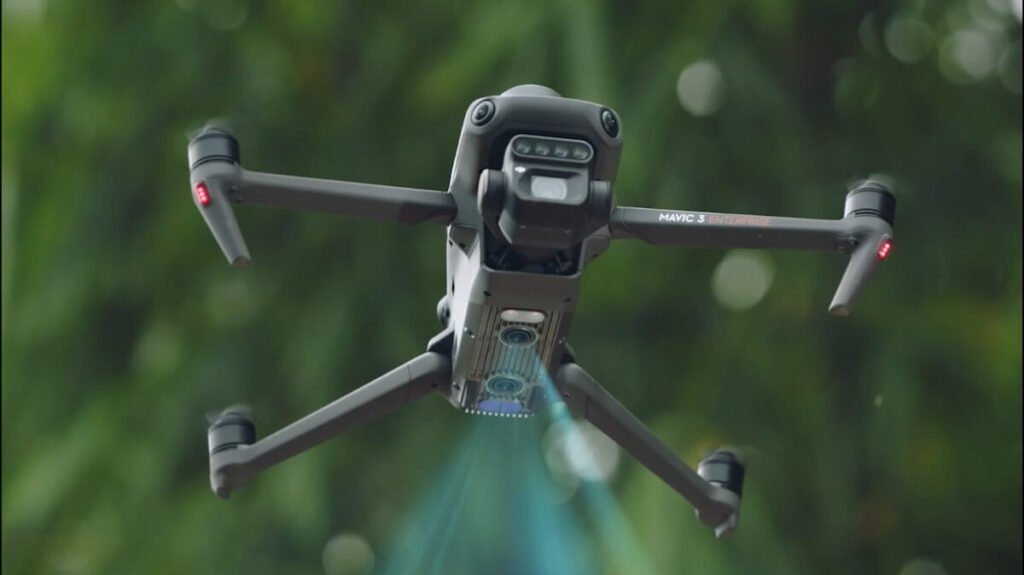Autrefois considérée comme une technologie futuriste réservée aux grandes opérations commerciales, drones agricoles sont maintenant plus petit, plus intelligent et étonnamment abordable—ce qui en fait des outils parfaits pour les petits agriculteurs.
Si vous exploitez une ferme de moins de 2 hectares, vous pourriez penser que les drones sont hors de portée. Mais aujourd'hui, ce n'est plus le cas. De nouvelles innovations ont permis aux drones :
- Compact et facile à piloter
- Faible coût (moins de 1 TP4T1 000)
- Doté de fonctionnalités d'IA pour le repérage, la pulvérisation et la cartographie
Dans ce guide, nous explorerons comment drones intelligents peut transformer les petites exploitations agricoles, augmenter la productivité et vous aider à économiser du temps et de l'argent, avec exemples concrets, tarifs, cas d'utilisation et conseils.
Que sont les drones agricoles ?
Les drones agricoles (également appelés ag-drones ou UAV) sont véhicules aériens sans pilote Conçus pour surveiller, gérer et améliorer les opérations agricoles, ils sont équipés des équipements suivants :
- Caméras (RVB, infrarouge, multispectral)
- Modules GPS pour la cartographie et la navigation
- Réservoirs de pulvérisation pour une application chimique ciblée
- systèmes d'IA pour la détection, la cartographie et l'analyse des maladies et des ravageurs
Pour les petites exploitations, les drones peuvent remplacer des tâches chronophages comme parcourir tout votre champ, en devinant où pulvériser ou en se fiant à des observations météorologiques et pédologiques incohérentes.
Avantages de l'utilisation de drones dans les petites exploitations agricoles
✅ Surveillance plus rapide des cultures
Couvrez un champ entier de 3 acres en 10 minutes, repérant les zones de parasites, le stress hydrique ou les carences en nutriments.
✅ Pulvérisation ciblée
Utiliser des drones pour appliquer des engrais ou des pesticides seulement là où c'est nécessaire, réduisant l’utilisation de produits chimiques de 30 à 50%.
✅ Cartographie des sols et de l'irrigation
Utiliser des caméras multispectrales pour identifier zones sèches, sol compacté ou problèmes de drainage.
✅ Détection précoce des maladies
Détectez les signes de maladies des cultures (décoloration, flétrissement) avant qu’ils ne soient visibles à l’œil nu.
✅ Économies de coûts au fil du temps
Économisez sur la main-d’œuvre, le carburant, les intrants chimiques et les pertes de récoltes : les drones peuvent être rentabilisés en une ou deux saisons.
Les petites exploitations agricoles peuvent-elles vraiment se permettre des drones ?
Oui, et voici pourquoi :
- Drones d'entrée de gamme adapté à la cartographie ou au coût de reconnaissance $400–$800
- Compact pulvérisation de drones sont désormais disponibles pour $1 200–$3 000
- De nombreux gouvernements et coopératives agricoles offrent subventions ou programmes de location
- Les modèles de partage communautaire permettent à plusieurs agriculteurs de partager la propriété des drones
Les drones ne sont pas seulement abordables : ils constituent un investissement intelligent.
Types de drones intelligents pour les petites exploitations agricoles
Décomposons les options de drones par fonction et par budget :
1. Drones de reconnaissance et de surveillance
But: Survolez votre ferme pour capturer des images et des vidéos haute résolution à des fins d'analyse.
Meilleurs choix :
DJI Mini 4 Pro

Coût : ~$759
Durée du vol : 34 minutes
Principales caractéristiques : caméra 4K, capteurs d'obstacles, points de cheminement GPS
Idéal pour : la surveillance hebdomadaire de la santé des cultures
Perroquet Anafi

Coût : ~$699
Caractéristiques : caméra 180°, boîtier pliable compact
Idéal pour : les fermes isolées avec un terrain difficile
2. Drones multispectraux (pour l'analyse des sols et de l'eau)
But: Utilisez l’imagerie infrarouge ou multispectrale pour évaluer la santé des plantes, les conditions du sol et le stress hydrique.
Meilleurs choix :
DJI Mavic 3 Multispectral

Coût : ~$3,500
Caractéristiques : Capteurs RVB + multispectraux (NDVI, NDRE)
Idéal pour : Les agriculteurs souhaitant des données plus approfondies sur le stress des plantes et leurs besoins en nutriments
3. Drones de pulvérisation (application ciblée d'engrais ou de pesticides)
But: Emportez des engrais liquides ou des pesticides et pulvérisez-les précisément sur les zones touchées.
Meilleurs choix :
DJI Agras T10

Coût : ~$3,000–$4,500
Capacité : réservoir de 10 L
Fonctionnalités : parcours guidés par GPS, alertes de remplissage automatique
Idéal pour : les fermes de légumes, de riz ou de fruits nécessitant une pulvérisation localisée
XAG V40

Coût : ~$4,000+
Connu pour : Cartographie IA + pulvérisation ultra-précise
Idéal pour : les fermes utilisant des pratiques régénératives ou biologiques avec une faible tolérance aux pulvérisations
Comment choisir le bon drone pour votre ferme
| Critères | Recommandations |
|---|---|
| Budget inférieur à $1 000 | DJI Mini 4 Pro ou Parrot Anafi pour le repérage visuel |
| Besoin d'analyser le sol/l'eau | Choisissez DJI Mavic 3 Multispectral |
| Pulvérisation requise | Découvrez le DJI Agras T10 ou les drones de pulvérisation d'entrée de gamme |
| Aucune expérience de vol préalable | Commencez avec des drones équipés de GPS et de capteurs d'obstacles |
| Vous ne voulez pas acheter ? | Envisagez de faire appel à des fournisseurs de services de drones locaux ou à des locations |
Cas d'utilisation : comment les petits agriculteurs utilisent les drones aujourd'hui
👨🏾🌾 Eric – Producteur de tomates de 2 acres au Kenya
Eric utilise un Mini drone DJI Il surveille chaque semaine le mildiou et repère les fuites d'irrigation. Il a réduit son utilisation de produits chimiques de 40%.
👩🏽🌾 Latha – Producteur de riz en Inde
Sa coopérative locale a investi dans un Agras T10 pour la pulvérisation. Le drone couvre 1 acre en 7 minutes et lui fait économiser 6 heures de travail manuel par semaine.
👨🏼🌾 Oscar – Responsable d'un verger de pommiers au Chili
Il utilise un drone multispectral pour identifier les arbres sous-performants et ajuster les plans nutritionnels, ce qui conduit à une amélioration du rendement du 15%.
Comment fonctionnent les drones dans les petites exploitations agricoles : un guide étape par étape
Étape 1 : Configuration
- Charger les batteries
- Logiciel de cartographie de charge (comme DroneDeploy ou DJI Terra)
- Planifiez la trajectoire de vol en fonction de votre tracé
Étape 2 : Décollage et vol
- Lancez-vous depuis une zone dégagée et sûre
- Surveiller le vol depuis un smartphone ou un contrôleur
- La plupart des drones reviennent automatiquement lorsque la batterie est faible
Étape 3 : Capturer les données
- Enregistrer des photos/vidéos ou des images multispectrales
- Marquez les taches de maladie ou les groupes de parasites
Étape 4 : Analyser
- Utiliser un logiciel pour générer :
- Cartes thermiques de la santé des cultures
- Cartes NDVI
- Chemins de pulvérisation
Étape 5 : Passez à l’action
- Spray ciblé
- Ajuster l'irrigation
- Surveiller les résultats chaque semaine
Meilleures applications et logiciels de drones pour les petits agriculteurs
| Nom de l'application | Cas d'utilisation | Plate-forme | Gratuit? |
|---|---|---|---|
| DJI Terra | Cartographie + vues de terrain 3D | Windows | ❌ |
| DroneDeploy | Santé des cultures, planification des vols | iOS/Android/Web | ✅ (basique) |
| Pix4Dfields | Analyse avancée + NDVI | Bureau | ❌ |
| Agremo | Prévision de rendement et détection des ravageurs | Web | ❌ |
| OpenDroneMap | Cartographie en champ libre | Linux/Windows | ✅ |
Surmonter les obstacles courants
⚠️ Vous ne savez pas comment en piloter un ?
Les drones modernes sont adaptés aux débutants : vol autonome, retour GPS, évitement d'obstacles.
⚠️ Trop cher ?
Partagez-en un avec vos voisins ou rejoignez une coopérative de drones. Les ministères de l'Agriculture offrent souvent des subventions.
⚠️ Des préoccupations juridiques ou liées à l’espace aérien ?
Vérifiez la réglementation locale. Dans la plupart des régions, les drones de moins de 250 g (comme le DJI Mini) sont autorisés. ne nécessite pas de permis.
Réglementation sur les drones pour les petites exploitations agricoles
✅ Ce qu'il faut vérifier :
- Avez-vous besoin d'enregistrer votre drone ?
- Quelle est la hauteur maximale de vol dans votre pays ?
- Existe-t-il des restrictions à proximité des lignes électriques, des aéroports ou des villages ?
Conseil de pro : Utilisez les drones tôt le matin ou juste avant le coucher du soleil : les vents sont plus calmes et la lumière est meilleure pour la prise de vue.
Avantages environnementaux de l'utilisation des drones
- Pulvérisation de précision = moins de ruissellement
- Un meilleur suivi = moins de surfertilisation
- Utilisation réduite du tracteur = émissions de carbone plus faibles
- Détection précoce = moins de dépendance chimique
Support des drones agriculture écologique pratiques et contribuent à répondre aux normes de certification biologique.
L'avenir : des essaims autonomes alimentés par l'IA
Au cours des 5 à 10 prochaines années, nous verrons :
- Des essaims de drones autonomes pour le repérage quotidien sur le terrain
- Des drones connectés à des capteurs IoT et stations météorologiques
- Une IA qui diagnostique et pulvérise automatiquement basé sur des données visuelles
Les petites exploitations deviendront micro-entreprises axées sur les données, et les drones seront au centre de tout cela.
✅ Plan d'action : Commencez petit, volez intelligemment
Voici comment commencer à utiliser des drones dans votre ferme :
- Choisissez un objectif (repérage, pulvérisation ou cartographie des cultures)
- Commencez avec un drone de base comme DJI Mini 4 Pro
- Télécharger le logiciel de planification de vol
- Effectuez une analyse hebdomadaire de 10 minutes de votre parcelle
- Tenir des registres de ce que vous trouvez et de la façon dont vous agissez
- Explorez la copropriété avec les agriculteurs à proximité
- Augmentez votre échelle à mesure que l'épargne augmente
Conclusion : Haute technologie, faible superficie
Les drones ne sont plus un luxe pour les grandes exploitations agricoles, ils sont un un outil puissant pour les petits exploitants cherchant à être compétitif, à conserver et à croître plus intelligemment.
De la détection précoce du mildiou à l’application précise d’engrais, un drone intelligent peut transformer une ferme de 5 acres en une centrale électrique à la pointe de la technologie.
Il est temps de prendre son envol.
📖 Suivant dans le Des rendements plus intelligents Série:
Chapitre 8 : Tableaux de bord des données agricoles : centraliser vos outils d'IA pour un impact maximal


